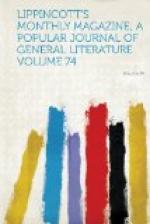It has been said that the authors regretted having written the Grande Duchesse, because the irony of history soon made a joke on Teutonic powers and principalities seem like unpatriotic satire. Certainly, they had no reason to be ashamed of the literary quality of their work: in its class it yields only to its predecessor. There is no single figure as fine as Calchas—General Boum is a coarser outline—but how humorous and how firm is the drawing of Prince Paul and Baron Grog! And Her Highness herself may be thought a cleverer sketch of youthful femininity than even the Hellenic Helen. It is hard to judge the play now. Custom has worn its freshness and made it too familiar: we know it too well to criticise it clearly. Besides, the actors have now overlaid the action with over-much “business.” But in spite of these difficulties the merits of the piece are sufficiently obvious: its constructive skill can be remarked; the first act, for example, is one of the best bits of exposition on the modern French stage.
Besides these plays for music, and besides the more important five-act comedies to be considered later, MM. Meilhac and Halevy are the authors of thirty or forty comic dramas—as they are called on the English stage—or farce-comedies in one, two, three, four, and even five acts, ranging in aim from the gentle satire of sentimentality in La Veuve to the outspoken farce of the Reveillon. Among the best of the longer of these comic plays are Tricoche et Cacolet and La Boule. Both were written for the Palais Royal, and they are models of the new dramatic species which came into existence at that theatre about twenty years ago, as M. Francisquc Sarcey recently reminded us in his interesting article on the Palais Royal in The Nineteenth Century. This new style of comic play may be termed realistic farce—realistic, because it starts from every-day life and the most matter-of-fact conditions; and farce, because it uses its exact facts only to further its fantasy and extravagance. Consider La Boule. Its first act is a model of accurate observation; it is a transcript from life; it is an inside view of a commonplace French household which incompatibility of temper has made unsupportable. And then take the following acts, and see how on this foundation of fact, and screened by an outward semblance of realism, there is erected the most laughable superstructure of fantastic farce. I remember hearing one of the two great comedians of the Theatre Francais, M. Coquelin, praise a comic actor of the Varietes whom we had lately seen in a rather cheap and flimsy farce, because he combined “la verite la plus absolue avec la fantasie la plus pure.” And this is the merit of La Boule: its most humorous inventions have their roots in the truth.




